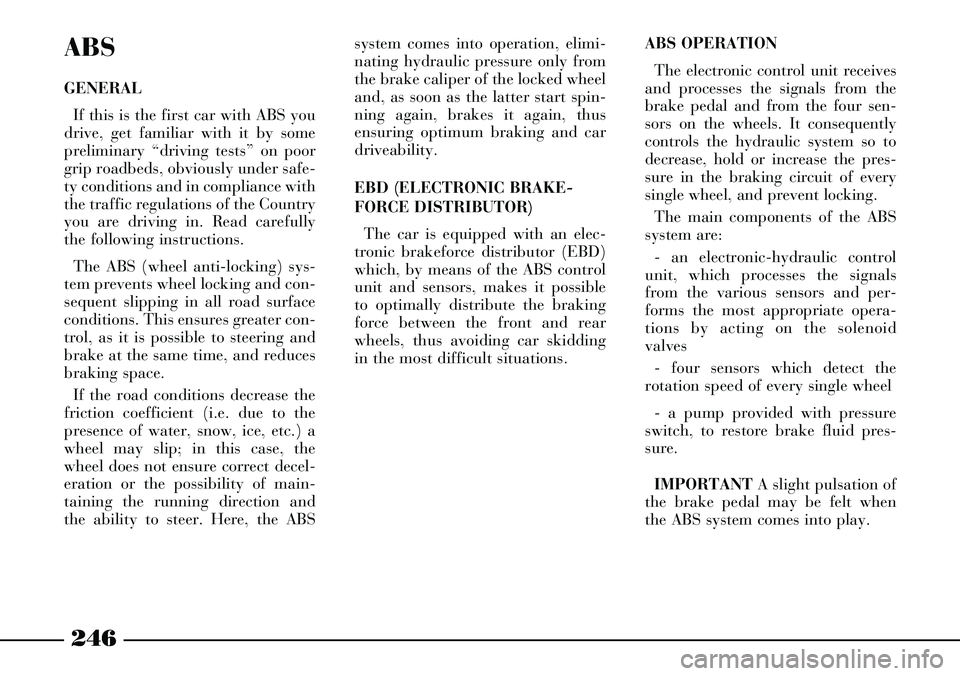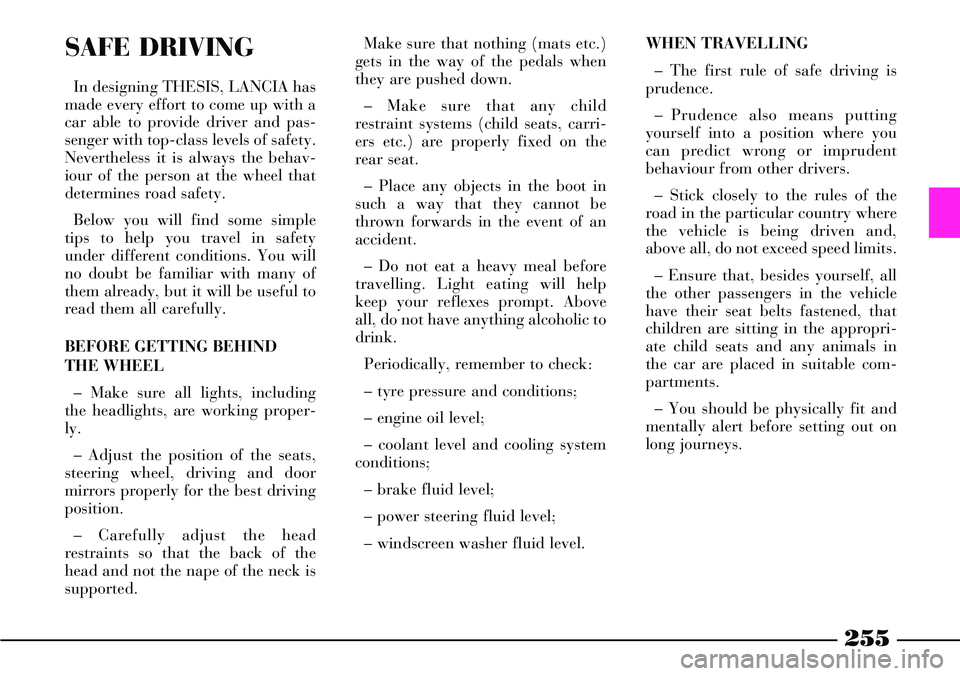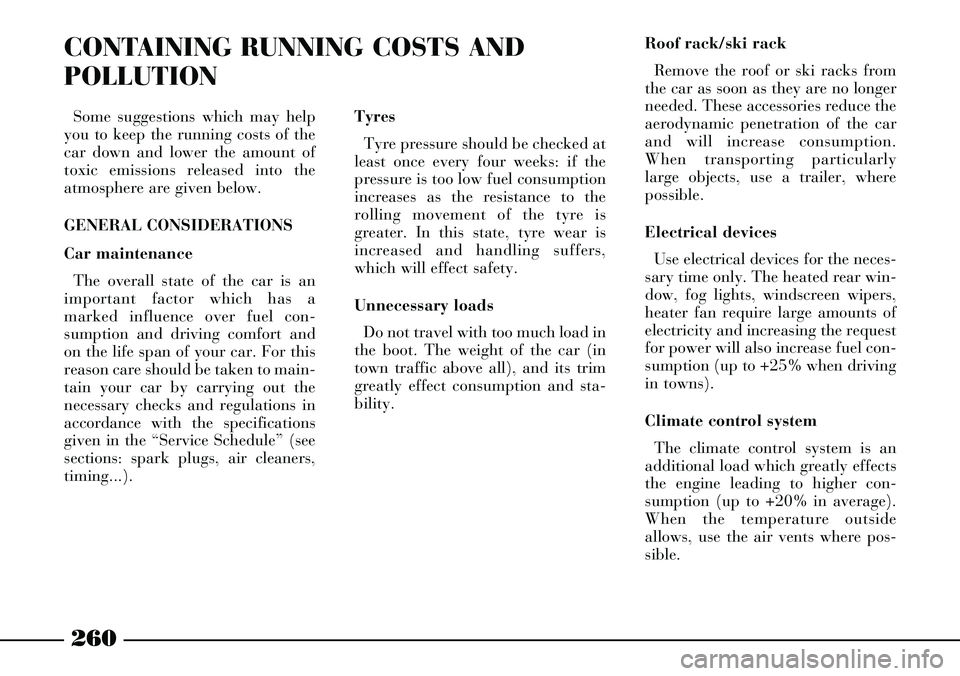pressure Lancia Thesis 2006 Owner handbook (in English)
[x] Cancel search | Manufacturer: LANCIA, Model Year: 2006, Model line: Thesis, Model: Lancia Thesis 2006Pages: 386, PDF Size: 8.69 MB
Page 201 of 386

200
Storing the speed
Move ring Ato any position other
than OFFand take the car to the
required speed.
Turn ring Bto (+), then release it.
The car speed will be stored and
shown on the instrument panel dis-
play; now, the accelerator pedal can
be released.
The car will continue at the con-
stant speed until one of the following
events occur:
– the brake pedal is pressed
– presence of a vehicle running
ahead more slowly along the run-
ning path, in the same running
direction.
IMPORTANTIf required (e.g. for
overtaking) you can accelerate sim-
ply by pressing the accelerator. The
car will return to the previously set
speed when the accelerator pedal is
released. If 160 km/h speed is
exceeded, restore the stored speed by
pressing C(RCL).Resetting the stored speed
If the system has been switched off
by pressing the brake pedal, the
stored speed can be resumed by
pressing button C(RCL).
Increasing the stored speed
The stored speed can be increased
in two ways:
– by pressing the accelerator and
storing the new speed (turning ring
Bto (+)
or
– by temporarily turning ring Bto
(+): each turn of the ring will corre-
spond to a 10 km/h speed increase,
while a continuous pressure will cor-
respond to a continuous speed
increase at intervals of 10 km/h.
Release ring B: the new speed will
automatically be stored.
The new set speed will be shown on
the display in place of the previous
one. Reducing the stored speed
The stored speed can be decreased
in two ways:
– by switching the device off (e.g.
by pressing the brake pedal) and
then storing the new speed (turning
ring Bto (+)
or
– by turning ring Bto (-) until the
new speed is reached. The new speed
will automatically be stored.
The new set speed will be shown on
the display in place of the previous
one.
Page 210 of 386

SENSORS
The system detecting the distance
from obstacles uses 4 sensors housed
in the front bumper (fig. 156) and 4
sensors housed in the rear bumper
(fig. 157).To ensure proper opera-
tion of the parking assist
system, it is essential that
the sensors placed on bumpers
are always free from mud, dirt,
snow or ice. When cleaning the sen-
sors, take the greatest
care not to scratch or
damage them; to this regard, do
not use dry, rough or hard cloths.
Sensors must be washed with
clean water, to which car sham-
poo can be added, if necessary. In
car-wash stations that use high-
pressure or steam-jet hydraulic
cleaning machines, clean the sen-
sors fast by keeping the nozzle at
a distance of at least 10 cm.
fig. 156
L0A0278b
fig. 157
L0A0277b
When the bumper needs
re-painting or the sensor
area needs touching-up
with paint, contact a Lancia
Dealership only. Incorrect appli-
cation of paint could adversely
affect the parking sensor opera-
tion.
209
Page 228 of 386

227
BOOT
The boot can be opened both from
the outside and the inside of the car.
IMPORTANT Faulty closing of the
boot is signalled by the lighting of
the relevant symbol on the multi-
function display, together with mes-
sage “BOOT OPEN”With the battery flat, or
after the interruption of
one of the protection
fuses, or if you want to disconnect
a loaded battery (e.g. for a car
stop period), before opening the
luggage compartment bonnet
carefully read and comply with
the instructions contained in the
paragraph “If battery is to be dis-
connected” in the chapter “In an
emergency”.
OPENING FROM THE INSIDE
Boot tailgate is opened electrically.
It can be opened only when the igni-
tion key is at MARand the car is
stopped, or for 3 minutes after turn-
ing the key to STOPwithout open-
ing or closing a door.
To open the boot, press button A
(fig. 192), placed on the central con-
sole, as follows:
– a short pressure of the button will
release the boot lock– a prolonged pressure of the but-
ton will release the lock and open
the boot.
Boot lifting is facilitated by the
action of gas dampers.
The dampers are cali-
brated so as to ensure
correct lifting of the boot
tailgate with the weights estab-
lished by the manufacturer.
Addition of extra equipment (e.g.
spoiler, etc.) can adversely affect
operation and safety of use.
fig. 192
L0A0167b
Page 229 of 386

228
OPENING FROM THE OUTSIDE
WITH THE KEY (fig. 193)
The boot lock is electrified: press
button Aon the tailgate to open it.
In an emergency (battery run down
or electrical system failure), the tail-
gate can be opened by fully turning
counterclockwise the key in the lock
and exerting at the same time a
slight pressure on the lower edge of
the number plate holder to reduce
the opening effort.
IMPORTANTIf the boot was
opened using the key, at closing the
automatic function will be deacti-
vated. To restore the automatic
function press button A.OPENING BY MEANS OF THE
REMOTE CONTROL
The tailgate can be opened from
the outside by pressing button A
(fig. 194) on the remote control,
even when the electronic alarm is on.
When the electronic alarm is on,
boot opening is accompanied by
double flashing of direction indica-
tors; boot closing is accompanied by
one flashing.
IMPORTANTIf the boot is opened
with the key when the electronic
alarm is on, the latter will not be
deactivated.If the electronic alarm is on, both
the volumetric protection and the
boot control sensor will be switched
off, and the system will emit (except
for versions of certain markets) two
beeps.
fig. 193
L0A0181b
fig. 194
L0A0179b
Page 240 of 386

239
In an emergency, the flap can be
released by pulling wire B(fig. 216)
on the right-hand side of the boot
inside the service compartment.
To open the compartment flap,
turn the catch C(fig. 217) to 1using
the ignition key and lower it.IMPORTANT The airtight seal of
the cap may lead to a slight increase
of pressure in the tank. A hissing
sound when the cap is removed is
therefore quite normal.
The cap is equipped with a device
which fastens it to the flap so that it
cannot be misplaced D(fig. 218).
While you are filling up, fasten the
cap to the device inside the flap as
shown in the figure.
Do not put naked flames
or lighted cigarettes near
the fuel filler hole as there
is a danger of fire. Do not bend too
close to the hole either so as not to
breathe in harmful vapours.REFUELLING
To guarantee full tank filling, carry
out two refuelling operations after the
first click of the fuel delivery gun. Avoid
further topping up operations that
could cause damages to the fuel system.
IMPORTANTRefuelling shall always
be performed with engine off and igni-
tion key to STOP. If the engine is off
but the key is to MAR, a wrong fuel
level could temporarily be indicated.
This is due to the internal system con-
trol logic and cannot be considered as
a system malfunctioning.
fig. 217
L0A0303b
fig. 218
L0A0014b
fig. 216
L0A0015b
Page 243 of 386

HEADLIGHTS
GAS-DISCHARGE (BI-XENO)
MAIN BEAM / DIPPED BEAM
HEADLIGHTS AND DYNAMIC
BEAM ADJUSTMENT DEVICE
These headlights, called Bi-Xeno,
use a lamp with a xenon-filled bulb,
both for the dipped beam and the
main beam headlights.
The main characteristics of this
type of headlights are:
– higher brilliancy
– higher light beam width and
adjustability
– lower consumption under work-
ing conditions
– longer bulb life.Each headlight is equipped with an
electronic control unit used to con-
trol supply voltage. Due to high bril-
liancy, bi-Xeno headlights require
the adoption of a dynamic beam
adjustment control system.
This system is controlled by an
electronic control unit operating at
two levels:
– constant headlight beam realign-
ment as a function of the car load
– dynamic headlight beam align-
ment to compensate car pitching
when running.Operation
Light is projected onto the road by
means of a spherical glass lens with
a large surface (70 mm diameter).
A deflector lifts and lowers, so that
light distribution is different for
both the main beam and dipped
beam headlights. The deflector is
electrically operated and the
mechanical lifting/lowering opera-
tion is performed real-time when
lights are switched.
The xenon lamp consists of a bulb
containing low-pressure xenon and
two electrodes.
To obtain light emission, an elec-
tric arc must be triggered between
the two electrodes and maintained.
Each headlight is equipped with a
control unit which:
– checks the voltage/current value
under working operation
– triggers the arc to the electrodes
and cause salt evaporation at
switching on.
242
Page 247 of 386

246
ABS
GENERAL
If this is the first car with ABS you
drive, get familiar with it by some
preliminary “driving tests” on poor
grip roadbeds, obviously under safe-
ty conditions and in compliance with
the traffic regulations of the Country
you are driving in. Read carefully
the following instructions.
The ABS (wheel anti-locking) sys-
tem prevents wheel locking and con-
sequent slipping in all road surface
conditions. This ensures greater con-
trol, as it is possible to steering and
brake at the same time, and reduces
braking space.
If the road conditions decrease the
friction coefficient (i.e. due to the
presence of water, snow, ice, etc.) a
wheel may slip; in this case, the
wheel does not ensure correct decel-
eration or the possibility of main-
taining the running direction and
the ability to steer. Here, the ABSsystem comes into operation, elimi-
nating hydraulic pressure only from
the brake caliper of the locked wheel
and, as soon as the latter start spin-
ning again, brakes it again, thus
ensuring optimum braking and car
driveability.
EBD (ELECTRONIC BRAKE-
FORCE DISTRIBUTOR)
The car is equipped with an elec-
tronic brakeforce distributor (EBD)
which, by means of the ABS control
unit and sensors, makes it possible
to optimally distribute the braking
force between the front and rear
wheels, thus avoiding car skidding
in the most difficult situations.ABS OPERATION
The electronic control unit receives
and processes the signals from the
brake pedal and from the four sen-
sors on the wheels. It consequently
controls the hydraulic system so to
decrease, hold or increase the pres-
sure in the braking circuit of every
single wheel, and prevent locking.
The main components of the ABS
system are:
- an electronic-hydraulic control
unit, which processes the signals
from the various sensors and per-
forms the most appropriate opera-
tions by acting on the solenoid
valves
- four sensors which detect the
rotation speed of every single wheel
- a pump provided with pressure
switch, to restore brake fluid pres-
sure.
IMPORTANTA slight pulsation of
the brake pedal may be felt when
the ABS system comes into play.
Page 256 of 386

255
SAFE DRIVING
In designing THESIS, LANCIA has
made every effort to come up with a
car able to provide driver and pas-
senger with top-class levels of safety.
Nevertheless it is always the behav-
iour of the person at the wheel that
determines road safety.
Below you will find some simple
tips to help you travel in safety
under different conditions. You will
no doubt be familiar with many of
them already, but it will be useful to
read them all carefully.
BEFORE GETTING BEHIND
THE WHEEL
– Make sure all lights, including
the headlights, are working proper-
ly.
– Adjust the position of the seats,
steering wheel, driving and door
mirrors properly for the best driving
position.
– Carefully adjust the head
restraints so that the back of the
head and not the nape of the neck is
supported. Make sure that nothing (mats etc.)
gets in the way of the pedals when
they are pushed down.
– Make sure that any child
restraint systems (child seats, carri-
ers etc.) are properly fixed on the
rear seat.
– Place any objects in the boot in
such a way that they cannot be
thrown forwards in the event of an
accident.
– Do not eat a heavy meal before
travelling. Light eating will help
keep your reflexes prompt. Above
all, do not have anything alcoholic to
drink.
Periodically, remember to check:
– tyre pressure and conditions;
– engine oil level;
– coolant level and cooling system
conditions;
– brake fluid level;
– power steering fluid level;
– windscreen washer fluid level. WHEN TRAVELLING
– The first rule of safe driving is
prudence.
– Prudence also means putting
yourself into a position where you
can predict wrong or imprudent
behaviour from other drivers.
– Stick closely to the rules of the
road in the particular country where
the vehicle is being driven and,
above all, do not exceed speed limits.
– Ensure that, besides yourself, all
the other passengers in the vehicle
have their seat belts fastened, that
children are sitting in the appropri-
ate child seats and any animals in
the car are placed in suitable com-
partments.
– You should be physically fit and
mentally alert before setting out on
long journeys.
Page 261 of 386

260
CONTAINING RUNNING COSTS AND
POLLUTION
Some suggestions which may help
you to keep the running costs of the
car down and lower the amount of
toxic emissions released into the
atmosphere are given below.
GENERAL CONSIDERATIONS
Car maintenance
The overall state of the car is an
important factor which has a
marked influence over fuel con-
sumption and driving comfort and
on the life span of your car. For this
reason care should be taken to main-
tain your car by carrying out the
necessary checks and regulations in
accordance with the specifications
given in the “Service Schedule” (see
sections: spark plugs, air cleaners,
timing...).Tyres
Tyre pressure should be checked at
least once every four weeks: if the
pressure is too low fuel consumption
increases as the resistance to the
rolling movement of the tyre is
greater. In this state, tyre wear is
increased and handling suffers,
which will effect safety.
Unnecessary loads
Do not travel with too much load in
the boot. The weight of the car (in
town traffic above all), and its trim
greatly effect consumption and sta-
bility.Roof rack/ski rack
Remove the roof or ski racks from
the car as soon as they are no longer
needed. These accessories reduce the
aerodynamic penetration of the car
and will increase consumption.
When transporting particularly
large objects, use a trailer, where
possible.
Electrical devices
Use electrical devices for the neces-
sary time only. The heated rear win-
dow, fog lights, windscreen wipers,
heater fan require large amounts of
electricity and increasing the request
for power will also increase fuel con-
sumption (up to +25% when driving
in towns).
Climate control system
The climate control system is an
additional load which greatly effects
the engine leading to higher con-
sumption (up to +20% in average).
When the temperature outside
allows, use the air vents where pos-
sible.
Page 268 of 386

267
WINTER TYRES
These tyres have been specifically
designed for use on snow and ice
and should be fitted in place of the
existing tyres.
Use only the homologated tyres
listed in log book.
Lancia Dealershipswill be glad
to provide advice on the most suit-
able type of tyres according to your
needs.
For information on the tyres to be
fitted, inflation pressure and winter
tyre specifications, follow the pre-
scriptions given in “Technical speci-
fications”.
The performance of winter tyres is
greatly reduced when the tread
depth is less than 4mm. In this situ-
ation it would be safer to have them
replaced.Due to winter tyre features, under
normal conditions of use or on long
motorway journeys, the perfor-
mance of these tyres is lower than
that of standard tyres.
The use of these tyres should there-
fore be limited to the conditions for
which they were designed and certi-
fied.
IMPORTANT When using winter
tyres with a maximum speed index
below the one that can be reached
by the car (increased by 5%), place
a suitable notice in the passenger
compartment to inform the driver of
the top speed at which the winter
tyre can run (as per EC Directive).All four tyres should be the same
(brand and track), to ensure greater
safety when driving, braking and
cornering.
Remember that it is inappropriate
to change the direction of rotation of
tyres.
The maximum speed for winter
tyres with “Q” marking is 160
km/h, with “T” marking is 190
km/h, whereas with “H” marking is
210 km/h. Always respect the high-
way code speed limit.